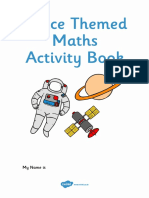Astronomy and Space
Astronomy and Space
Uploaded by
Trương Ngọc ThảoCopyright:
Available Formats
Astronomy and Space
Astronomy and Space
Uploaded by
Trương Ngọc ThảoOriginal Title
Copyright
Available Formats
Share this document
Did you find this document useful?
Is this content inappropriate?
Copyright:
Available Formats
Astronomy and Space
Astronomy and Space
Uploaded by
Trương Ngọc ThảoCopyright:
Available Formats
Usborne publishing for review only
This book is an exciting introduction to the
wonders of space. Find out how stars are born,
what it’s like to live in space, and lots more.
To discover more titles from Usborne Publishing,
visit www.usborne.com
Emily Bone and Hazel Maskell
£5.99
CAD $10.95 WARNING! Not suitable for children under 36 months,
due to small parts. Choking hazard.
JFMAMJJ SOND/12
02228/1 ATTENTION! Ne convient pas aux enfants de
Printed in Perai, Penang, Malaysia. moins de 36 mois en raison des petites pièces.
Risque de suffocation par ingestion.
Made with paper from a sustainable source.
Astronomy and Space Sticker Book Cover.indd 1 31/07/2012 10:20:07
Usborne publishing for review only
Emily Bone and Hazel Maskell
Illustrated by Paul Weston and Adam Larkum
Designed by Stephen Moncrieff and Emily Barden
Space experts: Stuart Atkinson and Professor Alec Boksenberg
CONTENTS
2 What’s in space? 16 Earth’s moon
4 Going into space 18 A home in space
6 Stars 20 Inner planets
8 Great galaxies 22 Mars
10 The Solar System 24 Gas giants
12 Burning Sun 26 Space lumps
14 Our planet 28 Watching space
30 Stargazing
32 Acknowledgements
01 Contents.indd 1 26/07/2012 10:33:54
Usborne publishing for review only
WHAT’S IN SPACE?
Space is enormous – our Earth and what we can see in the sky make up just a tiny
part of what’s out there. Everything that exists is known as the universe.
Filled with billions and billions of galaxies, stars, planets and moons, the universe is
so vast, scientists think they’ve only discovered around a tenth of it.
Most scientists believe that the universe
started life in a sudden, violent and fiery
explosion. This cooled as it spread out,
eventually turning into thick clouds,
then becoming stars and galaxies. This
theory is called the BIG BANG.
Distances in space are so great, they’re
measured in something called light years.
A light year is 10 million million km or
6 million million miles – the distance light
travels in one year.
Astronauts haven’t ventured very far yet. Most fly
in spacecraft around the Earth and some have even
landed on the Moon. This astronaut is floating out of
his spacecraft on a spacewalk above Earth.
One of the world’s leading
space agencies is NASA, the
National Aeronautics and Space
Administration, working on
behalf of the US government.
02-03 What's in space.indd 2 10/07/2012 14:04:07
Usborne publishing for review only
STARS
Stars are massive balls of hot, churning
gases that give off powerful heat and
light. Our nearest star is the Sun.
This is a group
of stars called
a star cluster.
GALAXIES
Billions of stars are collected into
Between galaxies, massive groups, called galaxies.
most of the universe Our galaxy is called the Milky Way.
has nothing at all in it – This is the Whirlpool Galaxy, 23
just vast stretches million light years from Earth.
of empty space.
PLANETARY SYSTEMS
Together, a star and everything that moves around it
is known as a planetary system. Our planetary system
is called the Solar System. There are at least 400 known
planetary systems in the Milky Way galaxy.
Sun
There are hundreds of
PLANETS man-made things in our
Huge balls of gas or Solar System, including space
rock called planets orbit probes and telescopes.
(move in a circle around)
a star. Earth is one of
eight planets that orbit
our star, the Sun.
Earth
ASTEROIDS AND COMETS
These are rocky, icy or gassy chunks MOONS
that orbit stars. Some planets have one
or more smaller balls of
rock or ice orbiting them,
called moons.
02-03 What's in space.indd 3 10/07/2012 14:04:08
Usborne publishing for review only
GOING INTO SPACE
People have been sending rockets into space since 1957. Since then, many
kinds of spacecraft have been launched and over 400 people have visited
space – all contributing to our growing understanding of the universe.
During the 1950s, the USA and A satellite is any object
the USSR (now Russia) raced to be that orbits another. Some
the first to send a spacecraft into man-made satellites are
orbit. The Russians achieved this used to gather information
on October 4, 1957, when they about the planet or moon
launched a satellite, Sputnik 1. they orbit; others transmit
Sputnik is Russian for communications signals.
‘Little Voyager’.
Animals were flown into space
before people – to make sure
living things could survive.
Among them was a chimpanzee
named Ham.
People who travel into space are
called astronauts, or cosmonauts
if they’re Russian. The names come
from Greek words: astron for
‘star’, kosmos for ‘universe’
and nautes for ‘sailor’.
On April 12, 1961, Russian cosmonaut
It takes extremely powerful rockets Yuri Gagarin became the first
to blast spacecraft into space. human in space. This poster
This is the launch of Apollo 11, the celebrates his achievement.
spacecraft used in 1969 for the
first manned mission to land on the
Moon. The rockets make up the lower
four-fifths and the crew sits in the
spacecraft at the very top.
These astronauts were part
of America’s first manned
space missions. They are in
the protective suits worn
during take-off.
04-05 going into space.indd 2 25/07/2012 13:38:28
Usborne publishing for review only
Space stations are large
spacecraft orbiting the Earth. Between 1981 and 2011, NASA used spacecraft called shuttles to
They are used as bases for take astronauts into orbit around Earth, and to deliver crew
astronauts to live in and and supplies to space stations. Shuttles were launched by
work on experiments. huge rockets and landed back on Earth like planes.
This is Skylab, the first
US space station. It was
launched in 1973 and
orbited the Earth until it
crashed back down in 1979.
Most space exploration is carried out by unmanned
spacecraft called probes that can go deep into space where
humans wouldn’t survive. They carry special equipment to
send images of distant planets and other data back to Earth.
Probes fly close
to planets or
moons.
Some probes have even
Sometimes they been launched to study
drop smaller probes the Sun and to send back
onto planets to images of its activity.
explore them.
This is Magellan, a probe that was
sent to study Venus in 1991.
Soon, private companies will be More than 500 people have already
taking tourists into space. This registered to go into space as
is an artist’s impression of a tourists with a private operator.
commercial spacecraft.
04-05 going into space.indd 3 25/07/2012 13:38:29
Usborne publishing for review only
STARS
When you look up at the sky on a clear night,
you’ll see thousands of tiny twinkling stars.
Each one is a massive ball of hot, exploding gases
that burns for billions of years.
Stars begin their lives in huge,
swirling clouds of gas and dust,
called nebulae (singular: nebula).
New stars are being born all
the time.
Nebulae can produce amazing The bright, white patches in this picture of the Orion
patterns and shapes. This is part of Nebula are new stars exploding into life. It is the closest
the Eagle Nebula. The points of light large nebula to Earth and can be seen with the naked eye.
are newly formed young stars.
HOW STARS ARE BORN
1. Over thousands of years, gas 2. The particles get so hot
and dust particles in the nebula they fuse together, making
collide and rub against each exploding balls of gas. These Stars often form together in clusters. The Pleiades is a
other, getting hotter and hotter. are stars.
star cluster that contains very hot, bright stars. It is
nicknamed the Seven Sisters, because you can often see
the brightest seven of its stars in Earth’s night sky.
Young stars often form open
clusters with the stars spaced
far apart. As they grow older,
they move closer together
into dense groups.
3. The leftover gas 4. The dust and gas in the
and dust swirl disk clump together forming
around a young planets that become part of
star in a big disc. a new planetary system.
06-07 Stars.indd 2 10/07/2012 14:05:52
Usborne publishing for review only
STAR TYPES
There are many different types of stars, from small
red dwarfs, to huge supergiants, hundreds of times
larger than the Sun.
Red dwarfs are the smallest and least powerful A yellow dwarf star Huge blue supergiant
stars. They’re dark red, making them difficult to produces a steady stars are hotter and
see. The nearest star to our Sun is a red dwarf, amount of light and heat. thousands of times
Proxima Centauri. It’s 4.2 light years from Earth. The Sun is a yellow dwarf. brighter than the Sun.
Three bright supergiants
form Orion’s Belt (see
page 30). The middle star
is 1,350 light years from
Earth, and 375,000 times
The brightest ‘star’in our sky is Sirius, brighter than the Sun.
or the Dog Star. It’s actually a small star
circling a bigger one.
DYING STARS
When their gas supply runs out, stars begin to die. Small stars This is the Hourglass Nebula
just fade away, but bigger stars expand as they cool. Eventually, around a white dwarf star.
a dying star sheds its outer layers in a huge nebula. The middle
becomes small and heavy, and is known as white dwarf star.
A huge star, such as a blue supergiant, ends its
life in a spectacular explosion, called a supernova.
Supernovae continue expanding for thousands
of years. This is the Tycho Supernova (below).
Astronomers first spotted it over 400 years ago.
Black hole
The middles of some supergiants collapse
and become extremely heavy. They suck in
everything around them, including light.
These are known as black holes.
Everything is pulled into the
hole in a giant spiral.
06-07 Stars.indd 3 10/07/2012 14:05:53
Usborne publishing for review only
GREAT GALAXIES
Galaxies are massive groups of billions of stars, nebulae, gas and dust,
stretching thousands of light years across. They form spectacular shapes.
Around 10,000 galaxies have been discovered so far – but there
are probably billions and billions in the universe.
Scientists think that mysterious
substances known as dark matter and
dark energy make up around 95% of
Spiral galaxies look a bit most galaxies, but no one is sure what
like whirlpools. They spin they are yet.
very slowly, and have
arms that curve out from
a bulging, bright middle.
A third of all known
galaxies are spirals.
Irregular galaxies are strange
shapes. They’re created when Dense egg- or ball-shaped clusters of old
galaxies crash into each stars are called elliptical galaxies. They
other. The Cartwheel Galaxy don’t contain many star-forming clouds.
(on the left) was made when The galaxy above is the Messier 60 Galaxy,
two spiral galaxies collided. 55 million light years from Earth.
The outer ring is a circle of
gas and dust left over from
the collision.
Collisions often create pockets of
powerful star-forming nebulae called
starbursts, where thousands of new
stars are born every year.
Other galaxies, like the ones above, are slowly merging
together. These are called the Mice Galaxies because they look
a bit like mice. Eventually, they will become one huge galaxy.
08-09 Galaxies.indd 2 10/07/2012 14:06:29
Usborne publishing for review only
THE MILKY WAY
Earth’s Sun is just one star among The middle of the Milky Way
billions in the Milky Way. It is a massive looks bright because there are
lots of stars close together.
spiral 100,000 light years across. This is There is a gigantic black hole
what it might look like. there too.
The Ancient Greeks
named the Milky Way
because they thought
that the bright band
of stars looked like a
river of milk.
Our Solar System is
found around here.
Areas of glowing blue, pink
and green gas are where
new stars are being born.
The Milky Way bulges around
the middle, where over 10 million stars
are crowded together. If you saw it
from the side, it would look like a pair
of fried eggs back to back.
On a clear night, you can sometimes see
part of the Milky Way as a bright, thick Most stars in the Milky Way probably
band of stars that stretches across the sky. have one or more planets orbiting
them. Scientists have already
discovered over 700 planets outside
our Solar System.
For centuries, people thought that the Milky
Way was all there was in the universe. Then,
in the 1920s, US astronomer Edwin Hubble
proved that spirals of light viewed through
telescopes were actually distant galaxies.
In 2004, the Hubble Space
Telescope took this photograph
millions of light years into
space. It revealed over 3,000
new galaxies. Each of the swirls
and spots of light is a galaxy.
08-09 Galaxies.indd 3 10/07/2012 14:06:30
Usborne publishing for review only
THE SOLAR SYSTEM
The Earth is one of eight planets that travel around the
Sun. Lots of other things orbit the Sun, too: moons
orbiting planets, small lumps of rock and dwarf planets.
Together, they are known as the Solar System.
The Sun and planets, and the distances
between them, are not shown to scale It would take over 12 years to fly
here – the Sun is so big, over a million from Earth to Neptune.
Earths could fit inside it.
VENUS SUN
These rings show each planet’s EARTH
near-circular orbit (path) around
the Sun. A planet’s year is the time
it takes to orbit the Sun once.
ASTEROID BELT MOON MERCURY
This is a big ring of rocky objects, called
asteroids, that orbit the Sun between MARS
Mars and Jupiter.
PHOBOS
CERES
The biggest asteroid in the Belt, Ceres is Mars has two DEIMOS
so big, scientists have classified it as a moons.
dwarf planet. Find out more on page 26.
SYSTEM IN MOTION
As well as moving around the Sun, everything in the Solar System
is spinning, too. A day is the time it takes for a planet to spin
the whole way around once. Earth’s day lasts just under 24 hours.
The side facing Everything in the Solar System moves because
away from the Sun of a pulling force called gravity. It keeps the
is dark. This is the planets spinning and moving around the Sun,
planet’s night. makes moons move around planets, and even
stops us from flying off into space.
10
10-11 The Solar System.indd 2 10/07/2012 14:07:16
Usborne publishing for review only
THE OUTER LIMITS The Solar System stretches
Far beyond Neptune is a band of icy, rocky objects as far as the limits of the
called the Kuiper Belt. Four known dwarf planets Sun’s energy – known as the
and their moons can be found there. heliopause. Two spacecraft
released in 1977, Voyager 1 and
Voyager 2, are getting close
to the heliopause. They’re the
furthest man-made objects
from Earth.
Pluto is the biggest Makemake
dwarf planet. Eris Haumea Voyager 1
JUPITER
Jupiter is the biggest planet in the
Solar System. Its four biggest moons
are about the same size as Mercury.
IO COMETS
Comets are lumps of
gas, dust and ice that
CALLISTO break up as they move.
EUROPA
GANYMEDE
SATURN
URANUS
Saturn’s rings are made
from ice and rock. TITANIA
Uranus’s biggest
moon
TITAN NEPTUNE
The biggest of
Saturn’s 60 moons
Neptune and Uranus are covered
TRITON in methane gas. Methane
Neptune’s biggest absorbs red light, which makes
moon the planets look blue and green.
11
10-11 The Solar System.indd 3 10/07/2012 14:07:17
Usborne publishing for review only
BURNING SUN
The Sun is our nearest star and the brightest thing you can
see in the sky. It is a massive ball of hydrogen gas that has
been burning for almost 5,000 million years.
The diameter of the Sun is over 100 times
that of the Earth. This tiny blue blob is the
size of the Earth compared to the Sun.
CORE
The Sun’s energy is made here.
CORE It is very hot (14 million degrees Celsius
or 25 million degrees Fahrenheit).
CONVECTIVE ZONE
The convective zone carries
CONV
ECTIVE ZONE
the energy out from the core.
The Sun’s energy comes from tiny
hydrogen particles, called atoms,
joining together. This creates huge
explosions – like millions of bombs
going off every second.
CHROMOSPHERE
This is the outer layer of the Sun. This photograph of
Energy-filled gases flood out to the Sun was taken
here, where they churn and bubble. by a spacecraft called
the Solar Dynamics
Observatory.
Heat from the surface escapes into a layer of hot gases
called the corona. It is very faint so you can only see it if
the Sun’s light is blocked out, as shown here. The corona
is 5,000 times hotter than the surface below.
12
12-13 burning sun.indd 2 25/07/2012 13:39:30
Usborne publishing for review only
WARNING!
SOLAR FLARES Never ever look directly at the Sun.
These are huge loops of burning gas that Its powerful light and heat could
shoot out into space. They can be 20 seriously damage your eyes.
times bigger than the Earth.
Dark patches on the surface of the Sun are
called sunspots. These are cooler areas that
form as a result of strong forces within the
Sun that stop heat from rising to the surface.
The Sun sends a stream of hot gas called solar
wind into space. When the wind hits the Earth’s
atmosphere it creates a beautiful light show,
called an aurora. An aurora can happen near
either the North or the South Pole.
This is the aurora borealis, or Northern Lights, near the
North Pole. The aurora in the south is called the aurora
australis, or Southern Lights.
FAST RISERS Solar wind is so
Small, straight jets of gas that fly out powerful it carries for
of the Sun and fall back down again are millions and millions of
known as fast risers. miles, to the very limits
of the Solar System.
13
12-13 burning sun.indd 3 25/07/2012 13:39:31
Usborne publishing for review only
OUR PLANET
A rocky planet with a breathable atmosphere and a surface
temperature that’s neither too hot nor too cold, Earth is
the only planet where we know life exists.
Earth has the essential ingredients for living
things to thrive: water, oxygen,
heat and light.
Over 70% of the Earth’s surface is covered in
water, making it look like a beautiful blue-green
marble. The white swirls are clouds. The green land
is covered in vegetation, where rain falls from the
clouds and makes plants grow.
Over half of a
person’s body is
water - we need it
to survive.
Earth’s air and water both contain oxygen,
which all creatures and plants need to live.
The Earth’s atmosphere is divided into
different layers:
The Earth’s atmosphere acts as a protective blanket of gases. 10,000km EXOSPHERE
(6,000 miles) The breathable air here
It traps heat and contains a gas called ozone that shields is very thin.
the Earth from the Sun’s harmful energy. You can see the
atmosphere as a blue haze above the clouds in this picture. 700km THERMOSPHERE
(400 miles) Aurorae are created here.
85km MESOSPHERE
(53 miles) Burns up small asteroids
(space rocks).
50km STRATOSPHERE
(31 miles) Contains ozone gas.
Planes fly here.
6-20km TROPOSPHERE
(3–12 miles) Where weather happens.
0-6km PLANETARY BOUNDARY LAYER
(0-3 miles) The air that we breathe.
14-15 Our Planet.indd 2 25/07/2012 13:40:15
Usborne publishing for review only
Temperatures vary at different places
around the world. Around the middle of
Earth’s surface, called the Equator, the
Sun hits directly. So it gets very hot,
reaching 58°C (130°F). But at the Poles, the
temperature can drop to -88°C (-126°F).
EARTH FACTS
Year: 365 Earth days
Day: 23 hours 56 minutes
Made of: rock There are living things on every part of
Diameter: 12,756km the Earth. Some are specially adapted for
(7,926 miles) life in different climates. Camels live in Penguins live in Antarctica, near the
Moons: 1 the desert and can survive for months South Pole, where it’s very cold.
without drinking.
There are around seven
billion people living on
Earth, and human activities
have an enormous impact
on the environment.
In this satellite image of a
farm in the US, you can see
the fields of crops as circles
and squares of green
and brown.
The city of Mumbai in India is one of
the most populated on Earth, with
12 million people. People living in
cities use up a huge amount of the
Since the 1950s, humans have sent thousands of satellites into space. Some Earth’s resources there and produce
gather information about Earth and its atmosphere that we can’t find out a lot of heat and waste.
from the ground – such as the movement of weather systems.
This is a satellite image of a huge storm
called a hurricane. Satellites can record the
rainfall and wind direction, and scientists
can use this information to predict where
hurricanes will hit.
Satellites can also map the
bottom of the deepest
oceans where mysterious
sea creatures live –
deeper than humans have
ever been.
15
14-15 Our Planet.indd 3 25/07/2012 13:40:16
Usborne publishing for review only
EARTH’S MOON
The brightest object in our night sky,
the Moon has been orbiting the Earth
for over four billion years.
Scientists think the Moon was made
The Moon is a bumpy, rocky place, covered with huge craters and high when another planet crashed into Earth.
mountains. Below is a map of the Moon’s surface. On a clear night, you can The rocks and dust created by the
easily see some of the biggest features with your naked eye. impact gradually formed into the Moon.
Traces of frozen water have been
found at the bottom of craters at
the Moon’s North and South Poles.
MOUNTAINS
The light patches on the Moon are high
ground, called montes or mountain
ranges. They look bright because sunlight
catches the mountain tops.
Montes Jura Crater Plato
Mare
Serenatis
Oceanus
Procellarum
The Moon is Mare
covered in a layer Tranquillitatis
Crater
of dust that Copernicus
sticks to anything
it touches.
Mare Nectaris
CRATERS
There are millions of craters on
the Moon. They were created when meteorites
bombarded its surface. The Moon’s largest crater
– on its far side – is 2,500km (1,550 miles) in
Crater Tycho
diameter and is 13km (8 miles) deep.
SEAS AND OCEANS
The dark patches are areas of hard lava. People used
to think that they were seas, so named them Mare
and Oceanus (Latin for ‘sea’ and ‘ocean’). One of the
In this photograph biggest is called Oceanus Procellarum – ‘Ocean of
you can see some of Storms’. Sailors believed that seeing this part of the
the round craters on Moon meant bad weather was coming.
the Moon’s surface.
16
16-17 Earth's Moon.indd 2 25/07/2012 13:41:00
Usborne publishing for review only
The Moon takes exactly the same time
to spin around once as it does to move
around the Earth. This means that the
same side is always facing us.
This is what the hidden, or far,
side looks like. There are more
craters and fewer ‘seas’ than on
the nearside.
The far side of the Moon is never
seen from Earth.
The Moon doesn’t produce any light. What we see is the Sun’s light
On July 20, 1969, the Apollo 11 spacecraft flew three reflecting off the Moon. As the Moon moves, the Sun lights up
astronauts to the Moon for the first time. Since then, different parts of its surface. That’s why it appears to change
six more manned spacecraft have flown there. shape. Here are some different shapes, or phases, of the Moon.
New Moon Full Moon Crescent Moon
On some missions, astronauts took a
buggy to explore the Moon’s surface. Eagle
This is Buzz Aldrin, a member of the Apollo 11
mission. Apollo orbited the Moon while Aldrin
and another astronaut, Neil Armstrong, flew to
the Moon’s surface in a lunar module nicknamed
Eagle. Aldrin set up the instrument to his right to
study the structure of the Moon.
MOON FACTS
Orbit: 27 Earth days
Day: 27 Earth days
Made of: rock
Diameter: 3,476km
(2,159 miles)
16-17 Earth's Moon.indd 3 25/07/2012 13:41:01
Usborne publishing for review only
A HOME IN SPACE
Orbiting the Earth around 330km (205 miles) above us, the
International Space Station (ISS) is the largest human-made object
in space. Astronauts from around the world live on board and carry SOLAR ARRAYS
out experiments that would only be possible in space. These huge solar
panels gather energy
from the Sun to
power the station.
ATV
This is a cargo vehicle
that brings up supplies SOYUZ
and carries down waste Carries crew between
to burn up on re-entry. Earth and the ISS
ROBOT ARM
KIBO Used to lift
astronauts and
A Japanese-built equipment
laboratory
Seventeen nations have worked to assemble
the ISS in stages. The first parts were
launched in 1998. The ISS is now complete,
but is being updated all the time.
ISS FACTS
Width: 109m (357 feet)
Height: 73m (239 feet)
Location: about 330km
(205 miles) above Earth The ISS travels around Earth once every 90
Speed: around 28,000 kmph minutes. In the time it takes to watch a
(17,398 mph) movie, the crew of the ISS experience both
Nations involved: 17 a sunrise and a sunset. That adds up to 16
dawns every 24 hours.
Max. no. of people on board: 6
18-19 Home in space.indd 2 13/07/2012 11:13:03
Usborne publishing for review only
The crew of the ISS carry out experiments
Every inch of room counts in the on themselves to find out how living in
ISS – it’s packed with scientific space affects the human body.
equipment as well as things
astronauts use in their free time.
On the left of this photograph
is an electric piano keyboard.
On the right is an exercise
machine with pedals.
One experiment involves wearing a cap
with sensors in it to measure how a
person’s brain is affected.
There is almost no gravity in the ISS, In another experiment,
so astronauts float around with very astronauts sort ‘p’s from ‘d’s
little effort. Their muscles could quickly on a viewfinder. It tests how
become weak, so they have to exercise low gravity affects someone’s
for two hours a day to keep fit. perception of up and down.
Inside the ISS, there is air to breathe and temperatures are kept at a
comfortable level, so astronauts wear everyday clothes. But, to survive while
working outside the space station, they have to wear a protective spacesuit.
A backpack carries
air to breathe.
Lights and
video camera
Astronauts talk to
each other using
a microphone and This astronaut is making
ear pieces inside repairs to the outside
the helmet. of the ISS. He is attached
to the robot arm so he
A water pouch in doesn’t float away.
the suit has a tube
that goes to the
The suit has a astronaut’s mouth.
control panel
on the front.
Padded gloves have
rubber fingertips
Suits have so the astronaut
different stripes can feel things
so astronauts more easily.
can identify one
another. Tubes of water
keep the suit
warm or cool.
19
18-19 Home in space.indd 3 13/07/2012 11:13:04
Usborne publishing for review only
INNER PLANETS
Mercury and Venus are small planets that orbit nearest
to the Sun. Although they both have uneven, rocky
surfaces, in other ways they are very different.
MERCURY
Mercury is the smallest planet in the Solar System.
It has a very thin atmosphere and its surface
is covered with hundreds of huge craters where
meteorites (space rocks) have crashed into it.
You can see the round craters in these pictures.
As meteorites hit Mercury, deposits of dust and
rock flew out either side of the impact site,
In this image, Mercury has been shaded creating spider-like patterns.
gold so features of the landscape stand out Meteorite
clearly. It’s actually a dull, dusty shade.
The biggest crater on Mercury is the Caloris Scientists think that
Basin. It is massive, stretching more than the Caloris Basin and
1,250km (800 miles) across – all of the British Weird Terrain were both
Isles could fit inside it. On the other side of the formed when a huge
planet is a bumpy, mountainous region known as meteorite hit Mercury,
the Weird Terrain. thousands of years ago.
In this photo, the Shock waves made rock
Caloris Basin has been buckle on the opposite side,
highlighted in yellow. making the Weird Terrain.
With a thin atmosphere, Mercury has no
protection from the Sun’s heat. During Sun
the day, Mercury’s surface gets very hot,
reaching 427°C (800°F).
Mercury
Mercury orbits the Sun four times
faster than the Earth. But it spins
around very slowly. A day on Mercury
is almost as long as its year.
MERCURY FACTS
Year: 88 Earth days
Day: 59 Earth days
Made of: rock
Diameter: 4,880km (3,032 miles)
Moons: 0
20
20-21 Inner planets.indd 2 25/07/2012 13:41:52
Usborne publishing for review only
VENUS
The hottest planet in the Solar System, Venus is shrouded in a thick layer of
acid clouds that trap the Sun’s heat, causing temperatures to rise to 480°C
(900°F). It is the closest planet to Earth, and can easily be seen in the night sky.
This photo, taken on June 5,
2012, shows the transit of Venus
in front of the Sun. You can see
Venus as a small, black circle near
the top right.
This happens when Venus passes
directly between Earth and the
Sun. It’s a rare event – the next
transit is due in 2117.
Venus can be seen shining
brightly close to the horizon
just after sunset, or just
before sunrise.
A space probe called Magellan has ‘seen’
under Venus’s clouds using a technology
called radar imaging. Radar beams passed
through the clouds, bounced off Venus’s
surface, then returned to the spacecraft.
This produced an image of the terrain.
VENUS FACTS
Magellan Year: 225 Earth days
Day: 243 Earth days
Made of: rock
Diameter: 12,100km
(7,518 miles)
Scientists used the length of the radar beam to measure
the height of different sections of land on Venus.
Moons: 0
This close-up image of Venus’s
landscape was created by
Magellan. The scratches are
valleys carved out by lava flows.
This image, highlighted blue, green and brown, was
made by the Magellan space probe. The blue areas are Using Magellan, scientists have found out about the surface of Venus.
huge plains of cooled lava, and the brown and green This is how the largest volcano on Venus, Maat Mons, might look.
areas are mountains and volcanoes.
20-21 Inner planets.indd 3 25/07/2012 13:41:53
Usborne publishing for review only
MARS
Also known as the Red Planet, Mars is small
and rocky with a very thin atmosphere.
It gets its reddish tint from its rusty,
iron-rich rocks. Its surface is cold, dusty
and dry but there was water once...
possibly life, too.
Mars has two tiny, misshapen moons
named Phobos and Deimos. They’re
asteroids that have been pulled into
the orbit of Mars.
This image of Mars is made up of hundreds of
images taken by a space probe.
Phobos is nearly 27km
(17 miles) long.
Mars is named after the
ancient Roman god of
war. The planet’s red Deimos is only
shade reminded ancient 15km (9 miles) long.
people of blood.
No human has ever been to Mars. It
would take over seven months to
travel each way – and no spacecraft
MARS FACTS is big enough to carry all the supplies
Year: 687 Earth days and fuel needed for a round trip.
Day: 24 hours 30 mins
Made of: rock
These canyons on Mars are deeper than the deepest canyon on Earth.
Diameter: 6,800km Although there’s no longer any water on the surface, many scientists
(4,200 miles) believe rivers and lakes helped form these canyons. Some think there
Moons: 2, both tiny may still be water deep underground.
COULD BE A PANORAMA
ACROSS THE BOTTOM? NON
STICKER
22-23 Mars New.indd 2 25/07/2012 13:42:41
Usborne publishing for review only
Scientists have landed robots on Mars to photograph the Antenna sends and
surface and examine its rocks. There are two kinds – landers, receives radio signals.
which stay in one position, and rovers, which move around.
‘Dead’ robots stay on Mars after they stop working. Sensor measures
temperature,
Cameras and wind
direction and
Antennae send and speed.
Solar panels gather receive radio signals.
energy from the Sun
to provide power.
Arm collects soil and
rock samples from
the ground.
Arm with multiple VIKING 1
tool attachments to This lander beamed back the first close-up view
examine soil and rocks
of the surface of Mars in 1976. For over six years,
scientists on Earth continued receiving information
from it about conditions on Mars.
Laser-firing device zaps
OPPORTUNITY
rocks, turning them into
a mist to be analyzed.
This rover has been exploring Mars since 2004,
beaming pictures and the results of its scientific The wheels and
experiments back to Earth. suspension are
designed for rough,
rocky terrain.
CURIOSITY
Curiosity is the latest rover, and the
largest yet – the size of a small car.
Launched from Earth in 2011, it’s
designed to examine rocks for signs
of water and life.
Landing a rover safely on
Mars is a huge challenge. This
is the landing apparatus
designed for Curiosity.
A parachute
slows the craft
down, and a heat
shield falls away.
This apparatus is
These scientists are building a Mars rover. They wear released, and thrusters
slow it down more. Rover is lowered
protective gear, so they don’t spread any germs that might from the apparatus,
infect the planet or affect the rover’s readings. onto the surface.
23
22-23 Mars New.indd 3 25/07/2012 13:42:43
Usborne publishing for review only
GAS GIANTS
Beyond Mars are the largest planets in the Solar
System. They don’t have solid, rocky surfaces, but
are mostly made up of gases.
JUPITER
The largest planet in the Solar System,
Jupiter is a massive ball of gases.
The stripes are bands of clouds, 1,000km
(600 miles) high. Deeper into the planet,
the gases become thicker and hotter
until they’re almost solid.
In the middle is Jupiter’s rocky core,
which is about the size of the Earth.
There are storms all
over Jupiter. The biggest
and most violent is the Jupiter’s bright clouds make it easy
Great Red Spot – a huge to notice in the night sky. Thousands
hurricane about the size of of years ago, Ancient Babylonian
Earth that has been raging astronomers wrote about a planet
for 300 years. thought to be Jupiter.
Jupiter has around 66 moons.
Here are some of the biggest.
IO
Io is covered in
volcanoes that can
erupt up to 139km
(86 miles) high.
Jupiter has faint rings of dust circling
around it. The dust comes from EUROPA
volcanic eruptions on the moons and A thick layer of ice on
from meteorites crashing into them. Europa’s surface might be
covering a vast ocean.
JUPITER FACTS
GANYMEDE Year: nearly 12 Earth years
Jupiter’s largest moon is Day: 9 hours, 50 minutes
THEBE the biggest in the Solar Made of: gas
Some of Jupiter’s moons are System. It is bigger than
the planet Mercury. Diameter: 142,984km (88,850 miles)
uneven shapes. This is Thebe. Its
surface is covered in huge craters. Moons: 66
24
24-25 Gas giants.indd 2 25/07/2012 13:43:25
Usborne publishing for review only
SATURN
Although slightly smaller than Jupiter, Saturn is still huge. Like
Jupiter, it is a gas planet, but the mixture of gases on Saturn make it
look golden. Saturn’s big, bright rings are its most famous feature.
Made up of millions of pieces of ice and rock, they stretch out over
300,000km (180,000 miles), but are only 20m (65ft) thick.
SATURN FACTS
Year: 29.5 Earth years
Day: 10 hours, 14 minutes
Made of: gas
Diameter: 120,536km (74,901 miles)
Moons: 62
In 2004, a spacecraft called Cassini
Cassini dropped a probe, Huygens, onto
Saturn’s largest moon, Titan, is the only Titan’s surface. Huygens found many
moon known to have an atmosphere. This is features similar to Earth, such as
what it looks like from space. huge lakes and sand dunes. But, at
-179°C (-290°F), it would be far too
cold for people to live there.
Huygens
URANUS AND NEPTUNE NEPTUNE FACTS
Year: 165 Earth years
Uranus and Neptune are gas planets far away from the Sun.
They don’t get much of the Sun’s heat and are extremely Day: 19 hours, 12 minutes
cold – most of the gas is thought to be frozen. Made of: gas
Diameter: 49,528km (30,775 miles)
Uranus spins as if it’s Moons: 13
been knocked on its side.
Something probably crashed
into the planet millions of Neptune is a stormy, windy
years ago. planet. The dark spots are huge
storms. Wispy clouds are also
blown around the planet by
2,000km/h (1,200mph) winds.
URANUS FACTS
Year: 84 Earth years
Day: 17 hours, 54 minutes
Made of: gas
Rings made from dust
Diameter: 51,118km (31,765 miles)
Moons: 27
25
24-25 Gas giants.indd 3 25/07/2012 13:43:27
Usborne publishing for review only
SPACE LUMPS
Along with planets, lots of smaller chunks
of rock, metal and ice also travel around
the Sun in our Solar System. These include JUPITER
asteroids, dwarf planets and comets. ITOKAWA
Itokawa is a small asteroid, 5km
(3 miles) across. A spacecraft,
ASTEROIDS Hayabusa, landed there and found
Asteroids are lumps of rock or metal left over from when that it was made of crumbly rubble.
our Solar System formed millions of years ago. Most are
Hayabusa
found in an area between the orbits of Mars and Jupiter,
called the Asteroid Belt.
There is a lot of man-made
junk floating in space,
too – astronauts’ cameras
and gloves, and waste bags
from past space missions.
IDA CERES
EROS
This asteroid has as a
The biggest asteroid in the
tiny moon orbiting it,
Belt – 950km (590 miles) across Most asteroids are odd
called Dactyl.
– Ceres is so big it has been shapes. Eros is 33km (20 miles)
re-classified a dwarf planet
MARS (see opposite).
long and has a big crater on its surface.
If asteroids collide with each other, they’re sometimes thrown off course, away from the Belt.
Big asteroids that get close to Earth are known as Near Earth Asteroids (NEA). Small ones are called meteoroids.
When a meteoroid enters Earth’s atmosphere, it burns
up and becomes visible as a meteor. Any solid pieces
that survive and hit the ground are called meteorites.
This huge crater in Arizona, USA, was made when a
meteorite hit 50,000 years ago.
Meteors are often called ‘shooting stars’.
If an NEA hit Earth, it would create They are streaks of light in the sky, caused
violent tidal waves and explosions that by meteoroids being burned up by the gases
might wipe out life. Scientists are in the Earth’s atmosphere. Sometimes, lots
developing lasers that could knock any of meteors fall at once in what’s known
NEAs heading to Earth off course. as a ‘meteor shower’.
26
26-27 Space rocks.indd 2 25/07/2012 13:44:09
Usborne publishing for review only
KUIPER BELT PLUTO NEPTUNE
Past Neptune, there is a huge band of rocky, icy When they discovered Pluto in the
and dusty lumps called the Kuiper Belt. 1930s, scientists thought it was a
The biggest lumps are called dwarf planets. They planet. But, since the discovery of
are almost round, like planets, but always orbit Eris, Pluto has been re-classified
the Sun within the Belt. as a dwarf planet.
The Kuiper Belt is around Pluto takes 248 Earth years to
8,000 million km (5,000 orbit the Sun, and has four moons.
million miles) away from the The largest is called Charon.
Sun. Many of the objects
take over 300 Earth years to Astronomers don’t know much about
complete one orbit. dwarf planets yet. A spacecraft is due
to reach Pluto in 2015, so we’ll be able
ERIS to see it clearly for the first time.
A dwarf planet discovered Charon
in 2005, Eris is bigger than
Pluto and takes 557 Earth
years to orbit the Sun. Dwarf planets have
oval-shaped orbits.
MAKEMAKE
About two-thirds the size of
Pluto, Makemake (pronounced
Eris is named after the Greek goddess
of conflict because astronomers
makee-makee) is mostly frozen.
Its year is 310 Earth years. HAUMEA
argued about whether to class Eris A small dwarf planet with two
and Pluto as planets or dwarfs. moons, it takes 283 Earth
There are thought to be over 100 dwarf planets years to orbit the Sun.
in the Kuiper Belt. But they’re so far away it’s
difficult for astronomers to see them.
COMETS
Comets are huge lumps of dust, gas and ice, nicknamed ‘dirty snowballs’.
As they pass close to the Sun, they start to melt and break up, leaving a
bright, long tail of gas and dust streaming out behind them. Occasionally,
a bright comet, with a long tail, can be seen in the sky.
One of the most famous
comets is Halley’s Comet.
It passes through the
Earth’s sky every 75 or
76 years. Its 1066 flyby
was recorded in a famous This photo of the comet NEAT was
embroidery called the taken in 2004. The white part of the
Bayeux Tapestry. comet is dust and ice; the purple and
blue areas contain a lot of gas.
27
26-27 Space rocks.indd 3 25/07/2012 13:44:10
Usborne publishing for review only
WATCHING SPACE
People have studied the night sky for tens of thousands of years.
Our ancestors used the stars and the Moon to keep track of the
seasons and for navigation at sea. More recently, we’ve developed
tools that enable us to see far, far away in space.
Many early stargazers were farmers, who wanted
to know when to plant and harvest crops. Others In 1609, an Italian scientist named Galileo Galilei built
were priests, who believed the stars were gods. a telescope powerful enough to see distant objects
in the sky.
One of Galilieo’s
telescopes
Galileo discovered things no one had ever seen
For the ancient Egyptians, the annual arrival before, including Jupiter’s largest moons,
of the star Sirius was a sign that the Nile sunspots, and craters on the Moon. His work also
floods were on the way. strongly supported the idea that the Earth goes
around the Sun – not the other way around, as
most people had believed until then.
In 1845, an astronomer named
William Parsons, Earl of Rosse,
completed the biggest telescope in
the world at the time, at his castle
home in Ireland. Named Leviathan,
This 16th-century brass astrolabe was it was so huge that he had to sit
used to measure the positions of the 15m (50 feet) above it to use it.
stars and Sun, and to tell the time.
These white domes make up the
Keck Observatory, in Hawaii,
USA. Each dome houses one of
the largest optical (light-using)
telescopes ever made. They
gather information about other
planets, stars and galaxies.
This image of Jupiter was captured by
The huge sliding hatch opens to reveal a massive one of the Keck telescopes. The two
hexagonal mirror, 10m (33 feet) across. A smaller bright spots are explosions, caused when
mirror is suspended above it. fragments of a comet hit the planet.
28
28-29 Watching space.indd 2 25/07/2012 13:45:07
Usborne publishing for review only
Radio waves from space can bring
information about objects that are too
dark or far away to be seen in ordinary
light. Telescopes that pick up radio
waves are usually dish-shaped. Some
dishes are very big; smaller ones are
arranged in huge groups called arrays.
This is a new radio telescope array
called ALMA, in Chile. It’s still being
built, and will eventually consist of
66 separate telescopes that can work
together as one gigantic telescope.
Some telescopes have been launched into Earth’s orbit, This shows the Hubble Space
where they have a clearer view of the stars. One is Telescope, as it floats in space.
the Hubble Space Telescope. Although its 2.4m (8 foot)
mirror is much smaller than in many Earth-based This section houses a
telescopes, it takes far better pictures. smaller mirror.
This door can be
closed to protect the
telescope from the
Sun’s light.
This antenna
sends images
and data back to
Earth. The solar panels
collect energy from
the Sun to power the
The Hubble Telescope took this picture telescope.
of a huge pillar of gas and dust around This part holds a big
7,500 light years away. mirror, and lots of
scientific instruments.
In 1977, NASA launched two spacecraft,
Voyager 1 and Voyager 2, to take a closer look at
planets Jupiter and Saturn. Voyager 2 also flew by
Uranus and Neptune. Both craft are now at the very
edge of the Solar System, and still send back readings. Do aliens exist? No one knows,
but a number of astronomers
are involved in the Search for
Voyager 1 In case they ever come across intelligent Extraterrestrial Intelligence,
life, both Voyager spacecraft carry an known as SETI. They look for
introduction to Earth – a disc of sounds, signals from aliens, and for
pictures, voices and music. planets where life could exist.
29
28-29 Watching space.indd 3 25/07/2012 13:45:08
Usborne publishing for review only
STARGAZING
On a clear night, the sky can be filled with a bewildering mass of stars.
But if you know where to look, you can pick out different shapes and
patterns, and even planets, without using any special equipment.
Early astronomers grouped the brightest
stars in the sky into imaginary pictures,
called constellations. Hundreds of years ago, sailors
and desert explorers looked to
One of the most the position of stars to help
famous constellations them find their way.
is Orion the Hunter
– named after a
hero in Greek
mythology.
This is how Orion
looks in the night sky.
The three brightest
stars in the middle
The bright ‘sword’ hanging are his ‘belt’.
from the belt is the Orion
Nebula (see page 7).
Here are some other
famous constellations:
Cassiopeia
the Queen
Scorpius
(scorpion)
Leo (lion)
Polaris
Apart from the Moon, the
Polaris is a bright star planets Venus and Jupiter are
that sits over the two of the brightest objects
North Pole, so it always in the night sky. As they’re
points north. It’s easy moving around the Sun their
to find because it’s positions vary, but you can
directly above a group check online to find out
of stars called the where you can see them on
Big Dipper – part of
Plough, or Big Dipper. a constellation called any particular night.
Ursa Major (the
Great Bear).
30
30-31 Star Gazing.indd 2 25/07/2012 13:46:24
Usborne publishing for review only
A P RIL
H C
M AR
STAR CHARTS Virgo MA
Y
Sextans
The Earth is constantly moving, which Leo
Y
AR
means that different stars appear Hydra
Coma
Berenices
RU
in the sky at different times of year. Boötes
FE B
Leo Minor Serpens
What you see also depends on where Caput
Cancer
you are – the northern hemisphere Monoceros Canes
J UN E
Venatici
faces a different set of stars from the Canis
southern hemisphere. Minor
Corona
Lynx Borealis
J A N UA R Y
Ursa
These star charts show where you Major Ophiuchus
Gemini
can find the most well-known Ursa Draco
Auriga Minor
constellations. Orion Hercules Serpens
Cauda Scutum
Camelopardalis
HOW TO USE
J ULY
Lyra
Face south if you’re in the northern
Cepheus Aquila
hemisphere, or north if you’re in the
BER
Perseus Cassiopeia Cygnus
southern. Turn the chart until the Vulpecula
ECEM
Taurus Triangulum Lacerta
current month is nearest to you. Look
up, and see what you can find. Delphinus
D
Eridanus Aries
A
Andromeda
UG
Pegasus Equuleus
ST U
The Crux, or Southern ER
Cross, can only be seen in B Pisces
the southern hemisphere. VE M Aquarius
NO Cetus EM B
SEPT
ER
O CT O B E R S E PT E M
O CT O B E R STAR CHART FOR
BER THE NORTHERN
R
BE HEMISPHERE
Pisces The white streaks on
V EM the charts show the
NO Pegasus Milky Way Galaxy.
AU
Cetus
Aquarius
GU
ST
Equuleus
Sculptor Piscis
BE R
Austrinus
Capricornus
D ECE M
Fornax Phoenix Grus
Eridanus
Indus Microscopium
J ULY
Aquila
Horologium Tucana Sagittarius
Orion
Caelum Hydrus
Reticulum Pavo Corona
Lepus Australis Scutum
Dorado
Columba Octans Serpens
J AN UAR Y
Pictor Mensa Apus Cauda
Telescopium
Chameleon
Ara
Volans Triangulum Ophiuchus
Australe Scorpius
Carina
Canis Circinus Norma
Musca
Monoceros Major
J U NE
Vela Crux
Puppis Lupus
Pyxis Centaurus
Antlia Serpens The Earth is spinning too, so the
RY
Libra Caput
UA
stars look as if they’re moving
R
Corvus across the night sky. This picture
EB
Hydra
F
Crater MA was taken over two hours. The
Sextans
Y streaks of light are stars.
STAR CHART FOR H
MAR C
Virgo
THE SOUTHERN A P R IL
HEMISPHERE
31
30-31 Star Gazing.indd 3 25/07/2012 13:46:25
Usborne publishing for review only
WHAT’S IN SPACE?
Pages 2-3
GOING INTO SPACE
Pages 4-5
Astronomy and Space SB_Sticker spreads.indd 2 25/07/2012 14:14:18
Usborne publishing for review only
GOING INTO SPACE CONTINUED
Pages 4-5
STARS
Pages 6-7
Astronomy and Space SB_Sticker spreads.indd 3 25/07/2012 14:14:20
Usborne publishing for review only
STARS CONTINUED
Pages 6-7
GREAT GALAXIES
Pages 8-9
THE SOLAR SYSTEM
Pages 10-11
Astronomy and Space SB_Sticker spreads.indd 4 25/07/2012 14:14:21
Usborne publishing for review only
BURNING SUN
Pages 12-13
OUR PLANET
Pages 14-15
Astronomy and Space SB_Sticker spreads.indd 5 25/07/2012 14:14:24
Usborne publishing for review only
OUR PLANET CONTINUED
Pages 14-15
EARTH’S MOON
Pages 16-17
Astronomy and Space SB_Sticker spreads.indd 6 25/07/2012 14:14:25
Usborne publishing for review only
A HOME IN SPACE
Pages 18-19
INNER PLANETS
Pages 20-21
Astronomy and Space SB_Sticker spreads.indd 7 25/07/2012 14:14:29
Usborne publishing for review only
INNER PLANETS
CONTINUED
Pages 20-21
MARS
Pages 22-23
Astronomy and Space SB_Sticker spreads.indd 8 25/07/2012 14:14:30
Usborne publishing for review only
MARS CONTINUED
Pages 22-23
GAS GIANTS
Pages 24-25
S PACE LUMPS
Pages 26-27
Astronomy and Space SB_Sticker spreads.indd 9 25/07/2012 14:14:33
Usborne publishing for review only
SPACE LUMPS
CONTINUED
Pages 26-27
WATCHING SPACE
Pages 28-29
Astronomy and Space SB_Sticker spreads.indd 10 25/07/2012 14:14:34
Usborne publishing for review only
WATCHING SPACE CONTINUED
Pages 28-29
STARGAZING
Pages 30-31
Astronomy and Space SB_Sticker spreads.indd 11 25/07/2012 14:14:37
You might also like
- Minecraft WorkbookDocument11 pagesMinecraft WorkbookLupita Obregon BarriosNo ratings yet
- Math in Focus 4B WorksheetDocument10 pagesMath in Focus 4B WorksheetBobbili PooliNo ratings yet
- Candy Store Business PlanDocument58 pagesCandy Store Business PlanSyafiq Sabran HasnanNo ratings yet
- Hello World!: Here Is Where Your Presentation BeginsDocument45 pagesHello World!: Here Is Where Your Presentation BeginsHà Dung NguyễnNo ratings yet
- My First Book of AnimalsDocument98 pagesMy First Book of Animals5jttgwdm4m100% (1)
- Al Mumtaz 4Document132 pagesAl Mumtaz 4SylviaK.RitongaNo ratings yet
- Name: Section: Roll NoDocument5 pagesName: Section: Roll NoKusuma HaranathNo ratings yet
- Y4AutEoB1 - Place Value BDocument2 pagesY4AutEoB1 - Place Value BRodaina MahmoudNo ratings yet
- Silly WillyDocument18 pagesSilly WillyThái TrươngNo ratings yet
- Pre 1ADocument3 pagesPre 1Afunny32910% (1)
- English Grade 1 Book 6Document10 pagesEnglish Grade 1 Book 6Nadia GeldenhuysNo ratings yet
- Wild SchoolDocument20 pagesWild School15176942126100% (1)
- T e 1637597874 Twinkl Phonics and Reading Scheme Overview - Ver - 1Document5 pagesT e 1637597874 Twinkl Phonics and Reading Scheme Overview - Ver - 1Maham AneeqNo ratings yet
- Spot The DifferencesDocument25 pagesSpot The DifferencesNajam SaqibNo ratings yet
- Y4 Autumn Block 2 SOL Addition and SubtractionDocument33 pagesY4 Autumn Block 2 SOL Addition and SubtractionSteven HopkinsNo ratings yet
- Results in Interpreting Data WorkbookDocument25 pagesResults in Interpreting Data WorkbooktraceyNo ratings yet
- DK Workbooks Math, First Grade (DK Publishing)Document62 pagesDK Workbooks Math, First Grade (DK Publishing)laavimanasNo ratings yet
- ABC ABC ABC ABC: at The ParkDocument34 pagesABC ABC ABC ABC: at The ParkyujieyinNo ratings yet
- Student Book ORT G2B Flood 1 20191230 191230163626Document18 pagesStudent Book ORT G2B Flood 1 20191230 191230163626Christina RogersNo ratings yet
- 02 - Std'05 - Environmental Studies PDFDocument207 pages02 - Std'05 - Environmental Studies PDFSumeet Nagpal RahiNo ratings yet
- Year 2 Full Summer TermDocument82 pagesYear 2 Full Summer TermYet Fong San100% (1)
- Maths 4b 3rd EditionDocument178 pagesMaths 4b 3rd Editionmarrie theresseNo ratings yet
- KidsWeb 4 Gu+¡a DocenteDocument89 pagesKidsWeb 4 Gu+¡a Docentejessica carucciNo ratings yet
- Practicing For The: TerranovaDocument34 pagesPracticing For The: TerranovaTatiana Shivchenco100% (1)
- Difference: Spot TheDocument35 pagesDifference: Spot ThemarianograssaNo ratings yet
- Lake FunDocument2 pagesLake FunanikcuteNo ratings yet
- Counting Guide 508 PDFDocument95 pagesCounting Guide 508 PDFSyauqi AnugrahNo ratings yet
- Storytime - February 2023Document54 pagesStorytime - February 2023P N100% (1)
- Crack The Code Math Addition Subtraction WorksheetsDocument13 pagesCrack The Code Math Addition Subtraction WorksheetsTrương Mỹ HạnhNo ratings yet
- Telling Time Maze Challenges:: Telling Time To The Hour, Half Hour and Quarter HourDocument8 pagesTelling Time Maze Challenges:: Telling Time To The Hour, Half Hour and Quarter HourzohraNo ratings yet
- National Geographic Little Kids - NovemberDecember 2023Document36 pagesNational Geographic Little Kids - NovemberDecember 2023Olesea100% (1)
- Space Themed Activity BookletDocument11 pagesSpace Themed Activity Bookletamerose rubyNo ratings yet
- USO Sample Papers For Class 7Document5 pagesUSO Sample Papers For Class 7Fikri DwiNo ratings yet
- Curious George & Achieve Workbooks - BrochureDocument4 pagesCurious George & Achieve Workbooks - BrochureHoughton Mifflin HarcourtNo ratings yet
- Cross Num PuzzleDocument1 pageCross Num PuzzlesharfexNo ratings yet
- ABC ABC ABC ABC: at The ShopsDocument34 pagesABC ABC ABC ABC: at The Shopsyujieyin100% (1)
- PropertiesofSolids3Dshapes 1Document2 pagesPropertiesofSolids3Dshapes 1OLIVEEN WILKS-SCOTTNo ratings yet
- Frontlist Sep-Dec 20 - CompressedDocument15 pagesFrontlist Sep-Dec 20 - CompressedPriscilla Octavia0% (1)
- National Geographic Little Kids I12 2023Document36 pagesNational Geographic Little Kids I12 2023Cecilia DaoNo ratings yet
- Human AnatomyDocument6 pagesHuman AnatomyhaumeivenusNo ratings yet
- TOEFL+Primary+R26L+Practice+Tests+Step+1+-+MAR400-LR (PDF - Io)Document31 pagesTOEFL+Primary+R26L+Practice+Tests+Step+1+-+MAR400-LR (PDF - Io)Nguyen Vu KhoiNo ratings yet
- Summer Camp CatalogDocument12 pagesSummer Camp CatalogGlobalOutlookNo ratings yet
- Kumon G1 EnglishDocument10 pagesKumon G1 Englishmendoxaadrian905No ratings yet
- (DK Findout!) Jerry Stone - Space Travel-DK Publishing (2019) - 2Document73 pages(DK Findout!) Jerry Stone - Space Travel-DK Publishing (2019) - 2Pradnyaanam BrahmNo ratings yet
- Waking UpDocument27 pagesWaking Upnre03782_smcNo ratings yet
- CREST English Prep KG WorkbookDocument91 pagesCREST English Prep KG WorkbookFora Shah100% (1)
- BFSU Lesson Plans Vol 1Document154 pagesBFSU Lesson Plans Vol 1a KNo ratings yet
- Pms Rubrics 1Document2 pagesPms Rubrics 1Bharti winnersNo ratings yet
- Progress in Math Workbook 2Document224 pagesProgress in Math Workbook 2asipraw01100% (1)
- CSBW Olympiad Book For Class 1Document10 pagesCSBW Olympiad Book For Class 1mansijain9418No ratings yet
- Class Nursery - Summer Holidays Homework 2023 (A)Document48 pagesClass Nursery - Summer Holidays Homework 2023 (A)YaqubNo ratings yet
- Sample Paper Syllabus 2016-17Document2 pagesSample Paper Syllabus 2016-17linguistAiaaNo ratings yet
- RM - Dl.a Is For AntDocument16 pagesRM - Dl.a Is For AntmihirikalpaniNo ratings yet
- Circle Pictures ABC WorksheetDocument26 pagesCircle Pictures ABC WorksheetRashid Frehat100% (1)
- Second Grade Social Studies CurriculumDocument12 pagesSecond Grade Social Studies CurriculumFrancis ZuluNo ratings yet
- Space Cards PDFDocument36 pagesSpace Cards PDFМария Евсеева100% (1)
- Free Counting WorksheetDocument1 pageFree Counting WorksheetCherry DuldulaoNo ratings yet
- Ladybug - January 2022Document40 pagesLadybug - January 2022Guruprasad BalajiNo ratings yet
- P6 Math WK 7 GClass PostDocument20 pagesP6 Math WK 7 GClass PostCorina HuNo ratings yet
- Mocomi TimePass The Magazine - Issue 39Document16 pagesMocomi TimePass The Magazine - Issue 39Mocomi KidsNo ratings yet
- Inner PlanetsDocument5 pagesInner PlanetsAndrewNo ratings yet
- The Children's Post, 21st April 2021Document6 pagesThe Children's Post, 21st April 2021Bhakti rautNo ratings yet
- ExtraterstDocument12 pagesExtraterstlidija46No ratings yet
- Book - 2009 - Anne Whitaker - Jupiter Meets Uranus - Feb. 1997 Jupiter Uranus ConjunctionDocument264 pagesBook - 2009 - Anne Whitaker - Jupiter Meets Uranus - Feb. 1997 Jupiter Uranus Conjunctionfarashak100% (1)
- Language Arts Subject For High School - 10th Grade - The Power of Humor XL by SlidesgoDocument85 pagesLanguage Arts Subject For High School - 10th Grade - The Power of Humor XL by Slidesgomoneymaestro2No ratings yet
- Class8 AstronomyDocument69 pagesClass8 AstronomyNikita AgrawalNo ratings yet
- Earth and Sky Day Camp BrowniesDocument23 pagesEarth and Sky Day Camp BrowniesfeylynrylNo ratings yet
- Science6 - Q4 - Module 5 - WK 6-7 - ADMDocument32 pagesScience6 - Q4 - Module 5 - WK 6-7 - ADMerwin_bacha100% (2)
- DPCC 1roDocument122 pagesDPCC 1rovaldesdelgadodennisNo ratings yet
- Me Estoy EnamorandoDocument67 pagesMe Estoy EnamorandoJorge Antonio Loza CachayNo ratings yet
- Killer Note - Anime Diary by SlidesgoDocument55 pagesKiller Note - Anime Diary by SlidesgoZila AffaNo ratings yet
- Social Studies History Subject For Middle School 6th Grade Ancient World HistoryDocument56 pagesSocial Studies History Subject For Middle School 6th Grade Ancient World HistoryMuhamMad IrfanNo ratings yet
- Brain Surgery InfographicsDocument36 pagesBrain Surgery InfographicsJana Bogosavljevic100% (1)
- Grade 5 Third Term Geo Exam 2023Document9 pagesGrade 5 Third Term Geo Exam 2023Tijani Basit AbiodunNo ratings yet
- Newspaper Clipping Style For History Class XL by SlidesgoDocument85 pagesNewspaper Clipping Style For History Class XL by Slidesgodebora.costa.43363No ratings yet
- Animated Healthcare Center by SlidesgoDocument57 pagesAnimated Healthcare Center by SlidesgojavierNo ratings yet
- Posters 2 Top Science 6Document7 pagesPosters 2 Top Science 6AnniNo ratings yet
- Graha Hora Timings or Subha Horai Timings - Divine BrahmandaDocument8 pagesGraha Hora Timings or Subha Horai Timings - Divine BrahmandaRamakrishna ChintalapatiNo ratings yet
- The History of The American Mafia by SlidesgoDocument55 pagesThe History of The American Mafia by SlidesgoSeftya MulyaNo ratings yet
- Home Decor & Furniture Catalog by SlidesgoDocument46 pagesHome Decor & Furniture Catalog by SlidesgoLine CVNo ratings yet
- Science DemoDocument47 pagesScience DemoMa. Angelica MedianaNo ratings yet
- Nail Polish CatalogDocument52 pagesNail Polish CatalogJessa Meneses DucoNo ratings yet
- History of Italian CinemaDocument57 pagesHistory of Italian Cinemajoaej86No ratings yet
- Accumulated Developmental Deficit Noel TylDocument7 pagesAccumulated Developmental Deficit Noel TylAycan ÖzenbaşNo ratings yet
- Earth Science (Ancient Astronomy)Document5 pagesEarth Science (Ancient Astronomy)Coleen Francesca SusayaNo ratings yet
- Observing Reflection PaperDocument3 pagesObserving Reflection PaperHikage23No ratings yet
- Brown Simple Story Reading Comprehension WorksheetDocument20 pagesBrown Simple Story Reading Comprehension WorksheetKim Shai TanoNo ratings yet
- Bullying Infographics by SlidesgoDocument33 pagesBullying Infographics by SlidesgoCongkrekNo ratings yet
- English 8 Review For Second Semester TestDocument5 pagesEnglish 8 Review For Second Semester TestthanhdanNo ratings yet
- Korean History Timeline Thesis XLDocument90 pagesKorean History Timeline Thesis XLnyn3260026No ratings yet

























































































